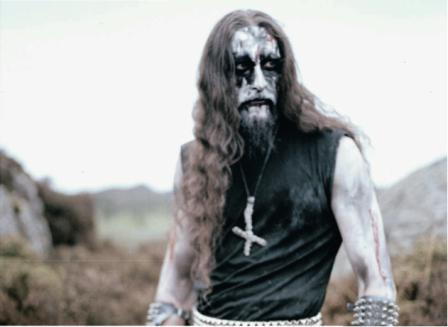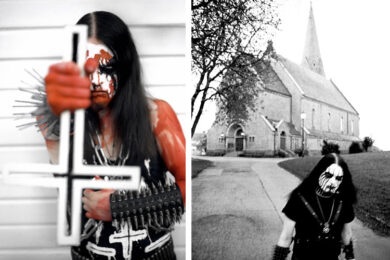In 2002, New York-based photographer Peter Beste packed up a bag of belongings and a camera and flew out to Norway with the idea of documenting the country’s most notorious export, Black Metal. Six years and seven trips later, his first book, True Norwegian Black Metal, hits the shelves. While some of Beste’s photos take the classically ’grimm’ route, others gently pry behind the mask, capturing the likes of Gorgoroth, Carpathian Forest, and Darkthrone in more natural surroundings. Intimate, almost conspiratorial, they give the impression of being welcomed into a lair. You start to wonder, did he become one of them? Then you remember that Beste’s next book project, due 2009, turns the lens on the hip-hop culture of his hometown, Houston, in much the same manner. Maybe he’s just good at his job.
Were the subjects of True Norwegian Black Metal receptive to the idea of being photographed?
“Yeah, for the most part. Some of these guys can be kind of media shy, but I showed them examples of the work, and told them my intentions. On my first trip I met Gorgoroth, Enslaved, and Nattefrost. Everybody was willing to give me an hour or so of their time.”
Did the aims of the project change over time?
“It may have become a little more critical as it went on. I came into it with a pretty open mind. I liked the music but I was no expert, that’s for sure. I was just there to observe and photograph what I saw.”
How do you mean ’critical’?
“Well, not critical, exactly. In the beginning I was looking for iconic, tough black metal photos " the fire breathing, the upturned crosses. But as I got to know them, I got more into to portraying them in ways they weren’t necessarily used to being portrayed. Maybe a little vulnerable, at times. I love that classic black metal aesthetic, those old Xerox-style black metal photos, and that’s one thing that drew me to black metal in the first place. But I’m not out to retake any old Darkthrone photos.”
What do you shoot with?
“Two thirds of the pictures were taken with a cheap little 35mm. A good deal of the larger ones were taken in medium format. Less than five in the whole book were taken digitally. I shoot really simply. I’d be travelling around a lot so I didn’t really have any kit, no lights, or anything " just a camera with a built-in flash. Using some elaborate lighting set up and an assistant, I’d almost certainly lose the moment. I’ve done that a few times, but it’s not really me.”

How are they socially? Do they open up?
“For the most part they’re enthusiastic metal guys who like to hang out, drink, listen to music. Not to demystify it, or anything.”
But the mystification around modern Black Metal so serious. It’s interesting to see that some of your subjects, the first and second wavers, are willing to give some of that up.
“I wanted to honour that in the book, but show a little bit beyond the fog " because if you completely demystify it, it’s no more fun. Everyone always wants to know all about the people, and that’s become my pet peeve for this project. It’s not my job to tell everyone what Gaahl is really like. Showing them in their natural environment is enough demystification for me. I’ll leave it to the fans to find out what they want about their idols.”
So your next project focuses on the Houston hip-hop scene?
“For the last four years whenever I’ve had time and money I’ve been flying out to Houston, photographing gangsta rappers, ghetto landscapes, nightclubs and strip clubs. I already have way more photos from that than I did from Norway.”
Did you notice any unexpected similarities between Houston rap musicians and Norwegian black metal musicians?
“Sure – there’s a history of violence in both movements, they’re both extreme youth musical movements, they’re very image conscious, there’s a dress and a behaviour within the scene. But of course, in Houston they grew up with nothing, while in Norway most of these guys are upper middle class.”
Do these worlds ever meet? Are the Norwegians aware of your Houston stuff, and vice-versa?
“Funnily enough| I mean, some of the black metal guys are big rap fans. I made Necrobutcher from Mayhem some CDs. He’s become a huge fan of Devin the Dude . My friends are joking I’m going to become responsible for some weird cross-pollination. But I don’t talk about Norway much with the rappers. Some of the religious stuff can rub them up the wrong way. Southern black culture is not very Satan-friendly. So I try not to get into that.”

But on the flipside, some of the Norwegian black metallers you’ve shot have expressed racist beliefs. Do they have a view of any of the Houston stuff you’ve shot?
“No, not at all. The Norwegians have never been weird about that. I think they’re quite curious about the Houston stuff. There is a little bit of racism in black metal, but you know what? Nowhere near as much as people think, and nowhere near as much as Lords of Chaos will have you believe. You know, that’s an entertaining book, and Varg’s an interesting guy, but you know, he’s just a Nazi that has nothing to do with black metal anymore. In the whole sum seven months I’ve spent out there, I heard at most at most a couple of light-hearted racist jokes. It exists, but it’s not as prevalent as one would believe.”
Do you think Norwegian black metallers are true outsiders? Is their worldview a product of the Norwegian character, or a reaction against?
“I think they would claim it’s a reaction against. It is a reaction against, but there are Norwegian attributes you’ll find in black metal. Solitude is a very Norwegian theme " solitude and introversion in general. Norwegians, they’re a lot quieter, a lot less outgoing than Texans, for example.”
And did you ever get a bit rowdy for them, then, with your Texan ways?
“[Laughter] Well if I ever did, they probably wouldn’t have told me. But you know, I try to adapt.”
Peter Beste took none of these photos.






